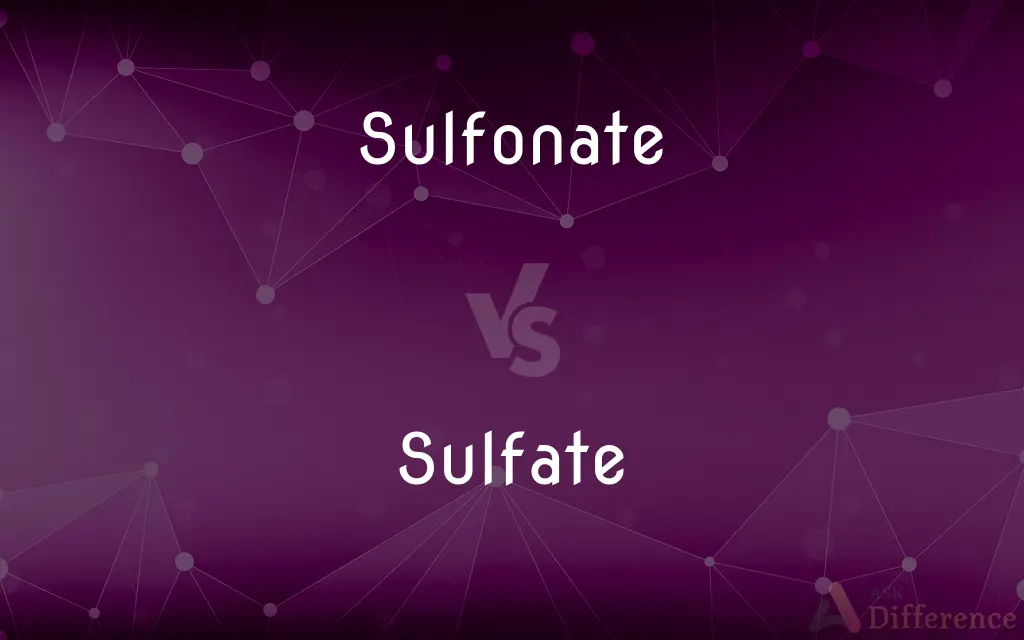Sulfonate vs. Sulfate — What's the Difference?
Edited by Tayyaba Rehman — By Fiza Rafique — Updated on September 30, 2023
Sulfonate is an anion derived from sulfonic acid (R-SO₃−), while sulfate is an anion from sulfuric acid (SO₄²−). Both are distinct in structure and origin.

Difference Between Sulfonate and Sulfate
Table of Contents
ADVERTISEMENT
Key Differences
Sulfonate and sulfate are terms referring to specific anions or salts derived from acids. Sulfonate originates from sulfonic acid and has the general formula R-SO₃−, where R represents an organic group. Sulfate, on the other hand, comes from sulfuric acid and has a general structure of SO₄²−.
The chemical makeup of sulfonate involves a sulfur atom bonded to three oxygen atoms and an organic component. This structure is frequently seen in surfactants, compounds that lower surface tension in liquids. Conversely, sulfate, with its four oxygen atoms bonded to a single sulfur atom, is a common constituent in various salts, detergents, and even in our atmosphere as an aerosol.
Sulfonate compounds, given their surfactant properties, find wide usage in household products and industrial processes. They play significant roles in the formulation of soaps and detergents due to their ability to trap oil and grease. Meanwhile, sulfate ions are abundant in nature, often resulting from the oxidation of sulfide minerals, and are key components in the Earth's sulfur cycle.
Another noteworthy distinction lies in their behavior in aqueous solutions. Sulfonates, being organic derivatives, are often more soluble in organic solvents compared to sulfates. Sulfates, being inorganic, are generally more soluble in water and can form a variety of salts with metals, such as copper sulfate or magnesium sulfate.
To sum up, while sulfonate and sulfate might seem similar at a cursory glance, they differ greatly in terms of chemical structure, origin, and applications. Both play crucial roles in industry and nature, making them subjects of continual interest and study.
ADVERTISEMENT
Comparison Chart
Origin
Derived from sulfonic acid
Derived from sulfuric acid
General Formula
R-SO₃−
SO₄²−
Common Use
Surfactants in soaps and detergents
Salts, detergents, and atmospheric aerosols
Bonding
Sulfur atom bonded to three oxygen atoms and R
Sulfur atom bonded to four oxygen atoms
Solubility
Often soluble in organic solvents
Generally water-soluble
Compare with Definitions
Sulfonate
Often acts as a surfactant in various solutions.
Sulfonate: The sulfonate group in the detergent aids in trapping grease.
Sulfate
Contains a sulfur atom bonded to four oxygen atoms.
The structure of the sulfate ion is tetrahedral.
Sulfonate
An anion or salt stemming from sulfonic acid.
Sulfonate: Sodium lauryl sulfonate is used in many cleaning products.
Sulfate
An anion or salt derived from sulfuric acid.
Epsom salt is essentially magnesium sulfate.
Sulfonate
Contains a sulfur atom linked to three oxygen atoms and an organic group.
Sulfonate: The R group in a sulfonate can vary, determining its properties.
Sulfate
Found abundantly in nature, especially in mineral deposits.
Gypsum is a mineral made of calcium sulfate.
Sulfonate
A derivative of sulfonic acid with a general formula R-SO₃−.
Sulfonate: When sulfonic acid loses its proton, it forms a sulfonate ion.
Sulfate
Commonly used in detergents, salts, and industrial applications.
Some shampoos are labeled sulfate-free due to potential hair dryness.
Sulfonate
Common in industrial processes and household products.
Sulfonate: Due to its surfactant properties, sulfonate is in many shampoos.
Sulfate
The sulfate or sulphate ion is a polyatomic anion with the empirical formula SO2−4. Salts, acid derivatives, and peroxides of sulfate are widely used in industry.
Sulfonate
A sulfonate is a salt or ester of a sulfonic acid. It contains the functional group R-SO−3, where R is an organic group.
Sulfate
The divalent group SO4 or a compound containing this group.
Sulfonate
A salt or ester of sulfonic acid.
Sulfate
To treat or react with sulfuric acid or a sulfate.
Sulfonate
To introduce into (an organic compound) one or more sulfonic acid groups.
Sulfate
(Electricity) To cause lead sulfate to accumulate on (the plates of a lead-acid storage battery).
Sulfonate
To treat with sulfonic acid.
Sulfate
To become sulfated.
Sulfonate
Any salt or ester of a sulfonic acid.
Sulfate
(organic chemistry) Any ester of sulfuric acid.
Sulfonate
To treat or react with a sulfonic acid, or to introduce such a group into a compound.
Sulfate
(inorganic chemistry) Any salt of sulfuric acid.
Sulfonate
A salt of sulphonic acid
Sulfate
To treat something with sulfuric acid, a sulfate, or with sulfur dioxide.
Sulfate
(of a lead-acid battery) To accumulate a deposit of lead sulfate.
Sulfate
A salt or ester of sulphuric acid
Sulfate
Key component in the Earth's sulfur cycle.
The oxidation of sulfide minerals can lead to sulfate formation.
Common Curiosities
Do sulfonate and sulfate come from the same acid?
No, sulfonate is from sulfonic acid, while sulfate is from sulfuric acid.
Are both sulfonate and sulfate found in detergents?
Yes, both can be used in detergents, but sulfonate often acts as a surfactant.
Is sulfate a natural component of the atmosphere?
Yes, sulfate can be an aerosol in the atmosphere, influencing climate.
Which has a more complex structure?
Sulfonate, as it contains an organic group (R) in its structure.
Is sulfate present in drinking water?
Sulfate can be in drinking water, usually from natural sources, but high levels can be concerning.
Which is generally more soluble in water?
Sulfate, being inorganic, is often more water-soluble than organic sulfonates.
Is copper sulfate a common compound?
Yes, copper sulfate is used in agriculture and as an algicide in ponds.
What’s the visual difference between the ions?
Sulfonate has three oxygen atoms and an R group; sulfate has four oxygen atoms.
What happens when sulfuric acid loses two protons?
It forms a sulfate ion, SO₄²−.
Why are some shampoos labeled "sulfate-free"?
Some believe sulfates can dry out hair and scalp, so they prefer sulfate-free products.
Are sulfonate compounds organic or inorganic?
Sulfonate compounds are organic due to the R (organic group) in their structure.
Why is sulfonate used in soaps?
Its surfactant properties help trap oil and grease, enhancing cleaning.
Can sulfonates be synthesized in labs?
Yes, sulfonates can be synthesized for various industrial applications.
Are both ions negatively charged?
Yes, both sulfonate and sulfate are anions and carry a negative charge.
In which products might I encounter sulfonate?
Sulfonate is common in detergents, shampoos, and some industrial solvents.
Share Your Discovery

Previous Comparison
Recent vs. Latest
Next Comparison
Paparazzo vs. PaparazziAuthor Spotlight
Written by
Fiza RafiqueFiza Rafique is a skilled content writer at AskDifference.com, where she meticulously refines and enhances written pieces. Drawing from her vast editorial expertise, Fiza ensures clarity, accuracy, and precision in every article. Passionate about language, she continually seeks to elevate the quality of content for readers worldwide.
Edited by
Tayyaba RehmanTayyaba Rehman is a distinguished writer, currently serving as a primary contributor to askdifference.com. As a researcher in semantics and etymology, Tayyaba's passion for the complexity of languages and their distinctions has found a perfect home on the platform. Tayyaba delves into the intricacies of language, distinguishing between commonly confused words and phrases, thereby providing clarity for readers worldwide.














































